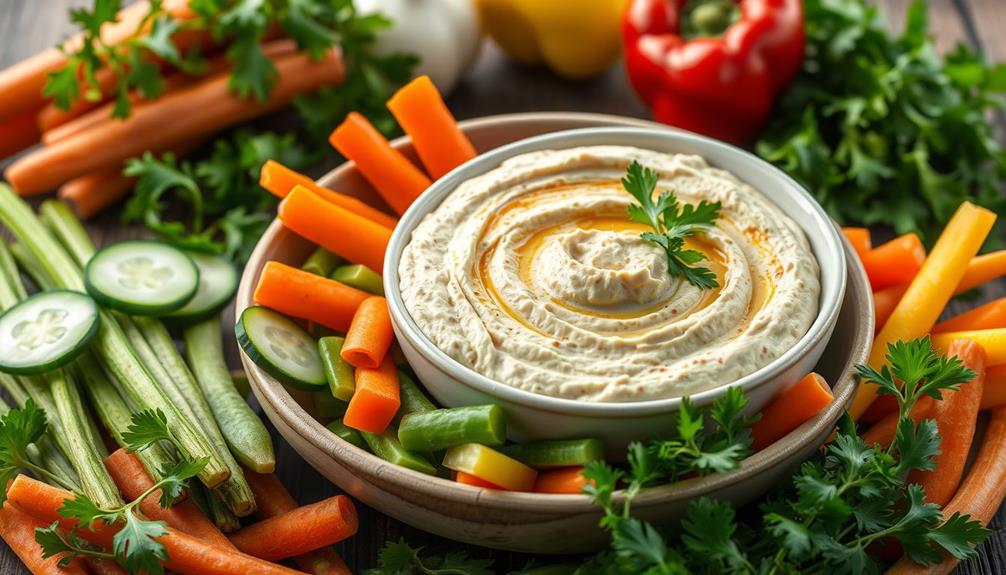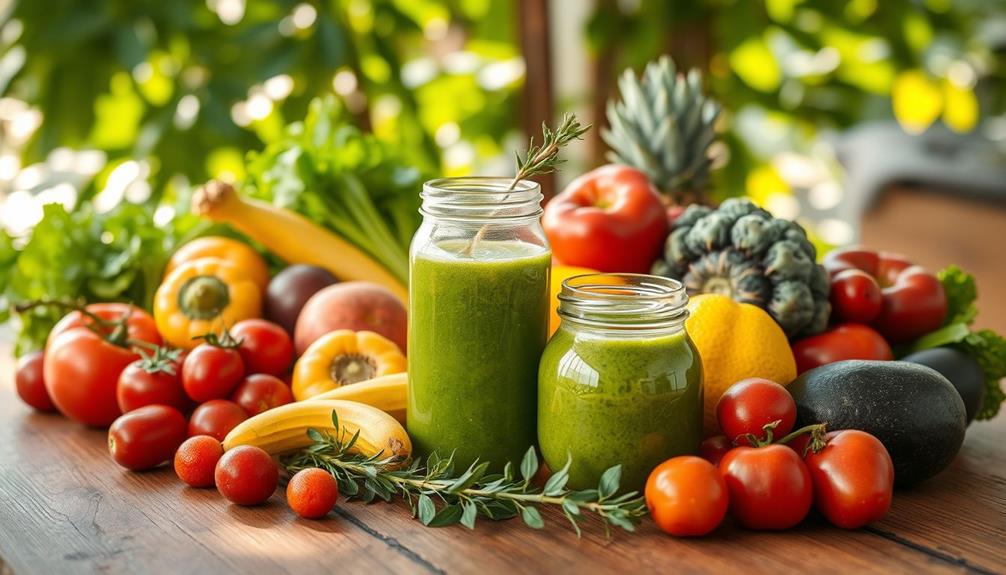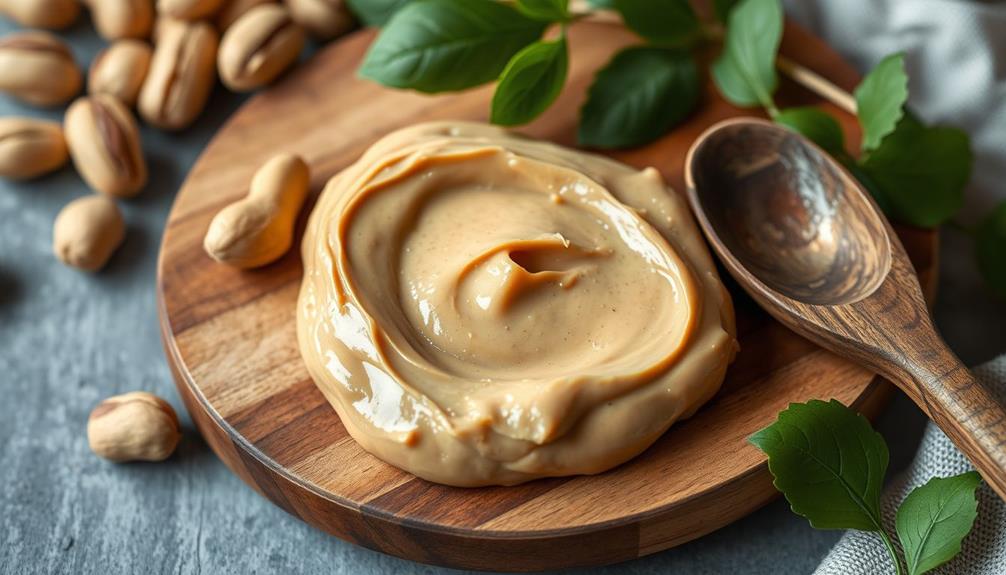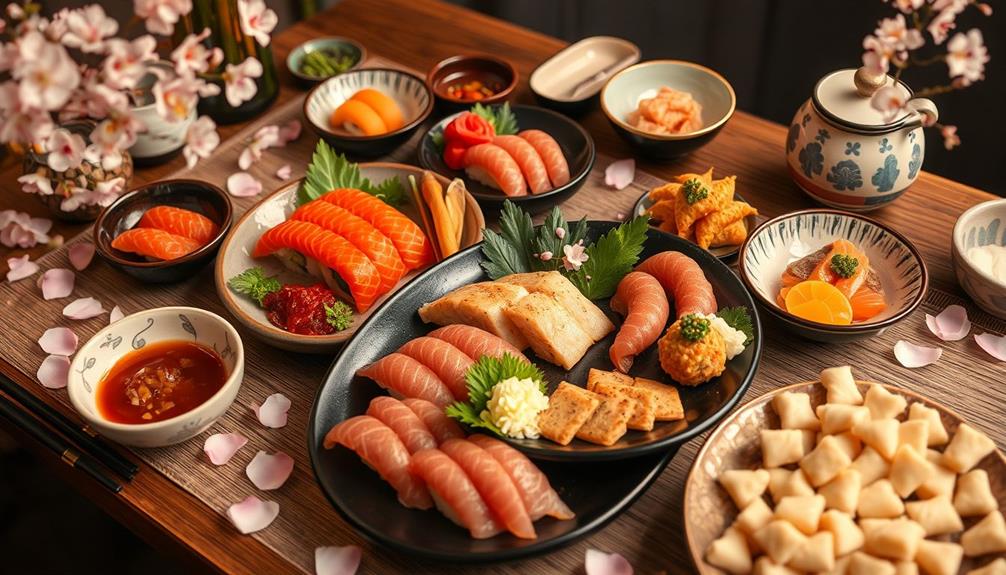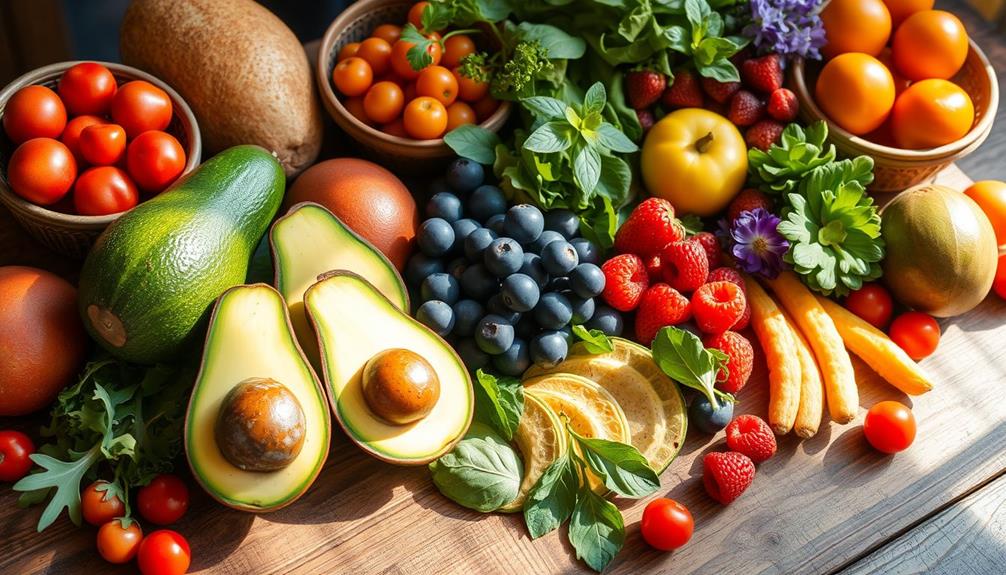Yes, you can eat hummus on a raw food diet, but you'll want to opt for raw hummus. Traditional hummus uses cooked chickpeas, which don't fit the raw food principles. With raw hummus, you'll use fresh vegetables, raw tahini, and cold-pressed olive oil, ensuring it's packed with nutrients and flavor. This version not only retains vitamins but also enhances the dish's texture by blending in sprouted chickpeas or nuts. Pair it with crunchy vegetable dippers for a satisfying snack. If you're enthusiastic to create delicious raw hummus variations and learn more tips, keep exploring!
Key Takeaways
- Raw hummus can be included in a raw food diet as it consists of unprocessed ingredients.
- Traditional hummus uses cooked chickpeas; raw hummus substitutes with fresh vegetables like zucchini or peas.
- High-quality ingredients, such as raw tahini and cold-pressed olive oil, are essential for raw hummus.
- Raw hummus offers higher vitamin content and preserves nutrients better due to the absence of cooking.
- Pair raw hummus with fresh vegetable dippers for added flavor and nutritional benefits.
Understanding Raw Food Diet
Embracing the principles of a raw food diet can lead to a transformative lifestyle choice focused on health and energy. Raw food diets emphasize unprocessed foods, primarily consisting of raw fruits, vegetables, nuts, seeds, and sprouted grains. By limiting cooking temperatures to a maximum of 104-118°F (40-48°C), you preserve essential nutrients and enzymes that can boost your well-being.
Incorporating a variety of natural remedies can further enhance your raw food experience. You'll find that the raw vegan diet offers numerous meal options through methods like juicing, blending, dehydrating, soaking, and sprouting. This allows you to enjoy a variety of delicious dishes while adhering to a plant-based diet.
While some raw food enthusiasts may choose to include raw animal products, many find great satisfaction in sticking to strictly plant-based options. Advocates of raw food diets often report increased energy levels, weight loss, improved digestion, and a reduced risk of chronic diseases due to their high intake of nutrient-rich foods.
However, it's essential for you to maintain a balanced intake of all food groups to avoid nutrient deficiencies, particularly in protein and vitamin B12. Understanding these principles will empower you to make informed choices on your raw food journey.
Nutritional Benefits of Hummus
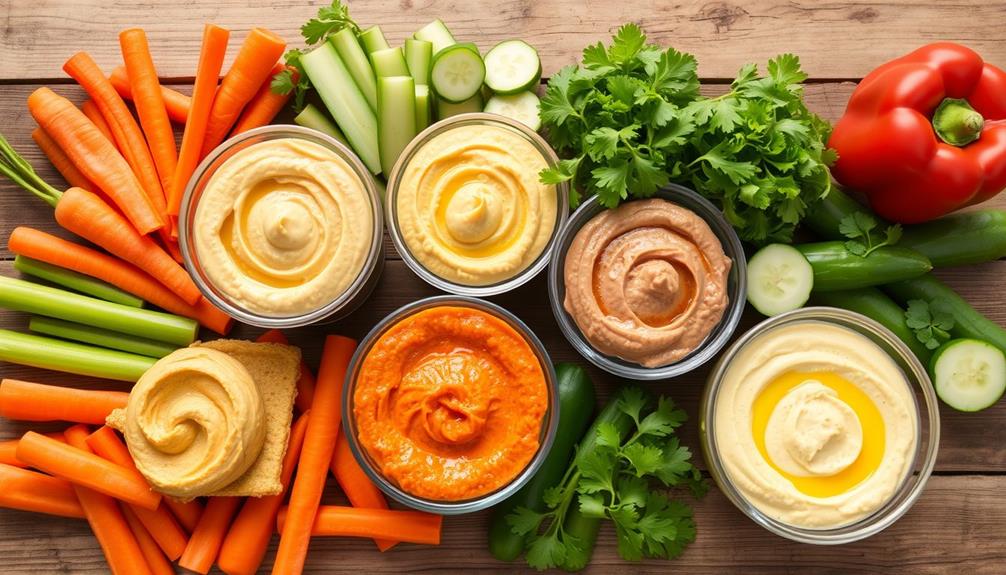
Nourishment is at the heart of a healthy diet, and hummus stands out as a powerhouse option for those following a raw food lifestyle. Made primarily from garbanzo beans, hummus is packed with nutritional benefits. A standard serving offers you about 2-3 grams of protein and 1-2 grams of dietary fiber, promoting satiety and supporting your digestive health.
Additionally, the antioxidants present in hummus ingredients can contribute to overall health, similar to the benefits of daily cranberry juice consumption.
The addition of tahini not only enhances the flavor but also provides healthy fats, particularly monounsaturated fats, which are great for your heart. Plus, the antioxidants found in ingredients like garlic and lemon juice help combat oxidative stress in your body, contributing to overall wellness.
Another significant advantage of hummus is its low glycemic index, making it an ideal choice for maintaining stable blood sugar levels. This is particularly beneficial if you're exploring plant-based diets or looking to incorporate more raw food recipes into your meals.
Raw Vs. Traditional Hummus
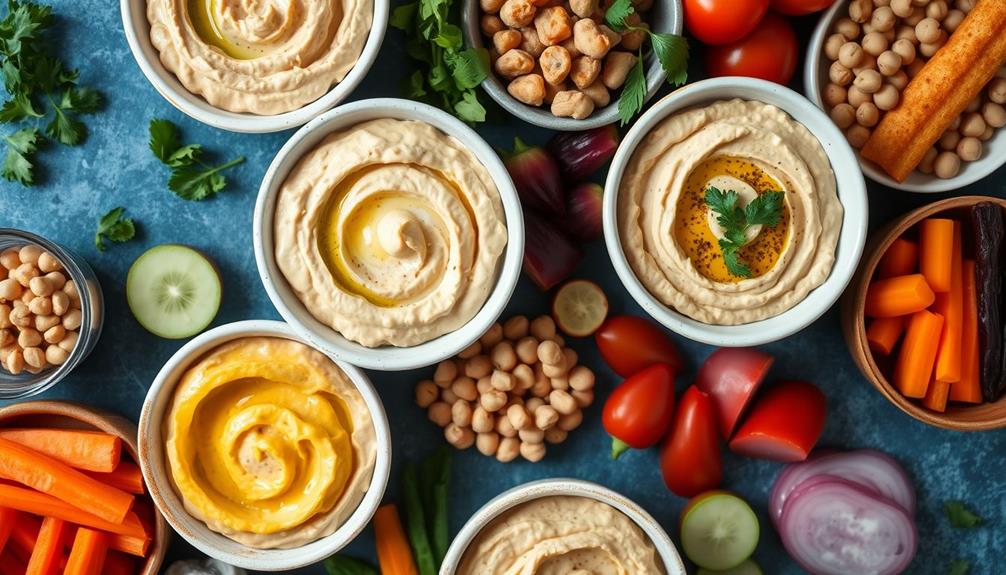
When you compare raw hummus to traditional hummus, you'll notice significant differences in ingredients, preparation methods, and nutritional value.
Traditional hummus uses cooked chickpeas and may contain roasted tahini, while raw versions rely on fresh vegetables and raw tahini to meet dietary standards.
Understanding dietary needs is essential when choosing the best option for your raw food lifestyle.
Additionally, raw hummus can incorporate a variety of spices and herbs, enhancing its flavor profile while keeping it aligned with raw food principles.
Ingredients Comparison
While traditional hummus relies on cooked garbanzo beans, raw hummus takes a different approach by using fresh peas or zucchini to keep it compliant with raw food principles. This fundamental difference in ingredients creates a unique flavor profile and texture that you'll notice right away.
Here's a quick comparison of the key ingredients:
| Traditional Hummus | Raw Hummus |
|---|---|
| Cooked garbanzo beans | Fresh peas or zucchini |
| Conventional tahini | Raw tahini |
| Olive oil (processed) | Cold-pressed olive oil |
In addition to the ingredient swap, raw hummus often incorporates nuts or seeds for creaminess, enhancing its nutritional value. You'll find that raw hummus may offer higher levels of certain vitamins and enzymes due to the absence of cooking, making it a more nutrient-dense option for those on a raw or vegan diet.
Preparation Methods
How do the preparation methods for raw and traditional hummus differ? The key distinction lies in the ingredients and cooking processes used. Traditional hummus is made from cooked garbanzo beans, disqualifying it from a raw food diet. In contrast, you can create a raw vegan hummus recipe using sprouted garbanzo beans or even zucchini as a base.
For an added twist, consider incorporating fresh herbs and spices for enhanced flavor, similar to the preparation of Flavorful Appetizers.
Here are three primary preparation methods you can follow for raw hummus:
- Soaking: Start by soaking your sprouted grains or nuts to enhance their digestibility.
- Sprouting: For a truly raw experience, sprout your garbanzo beans, which adds nutrients and flavor.
- Blending: Blend fresh vegetables, herbs, nuts, and olive oil in a high-speed blender to achieve a smooth texture, avoiding any cooking.
Unlike traditional hummus, which requires cooking and mashing, raw hummus involves minimal processing, allowing you to enjoy the robust flavors and nutrients of fresh ingredients.
This method not only aligns with raw food principles but also provides a delicious way to enjoy hummus without sacrificing your dietary preferences.
Nutritional Differences
Although traditional hummus is beloved for its creamy texture and rich flavor, raw hummus offers unique nutritional advantages that cater to health-conscious eaters. One major difference lies in the ingredients; while traditional hummus uses cooked chickpeas, raw hummus often incorporates fresh vegetables like peas or zucchini. This substitution preserves more enzymes and nutrients, leading to a higher vitamin content, especially for nutrients like vitamin C and B vitamins that can diminish through cooking.
Additionally, incorporating essential oils for overall wellness into your diet can further enhance health benefits.
In terms of caloric content, raw hummus tends to be lower since it usually contains fewer high-calorie components like tahini and olive oil. Instead, it focuses on whole, unprocessed vegetables, which can boost your fiber intake considerably.
However, you should note that the protein content in raw hummus might be lower, as it relies on ingredients that typically have less protein compared to cooked chickpeas.
Ultimately, understanding these nutritional differences can help you choose the right type of hummus for your raw diet. Whether you prefer traditional or raw, both can fit into your repertoire of healthy foods, depending on your specific nutritional goals.
Ingredients for Raw Hummus
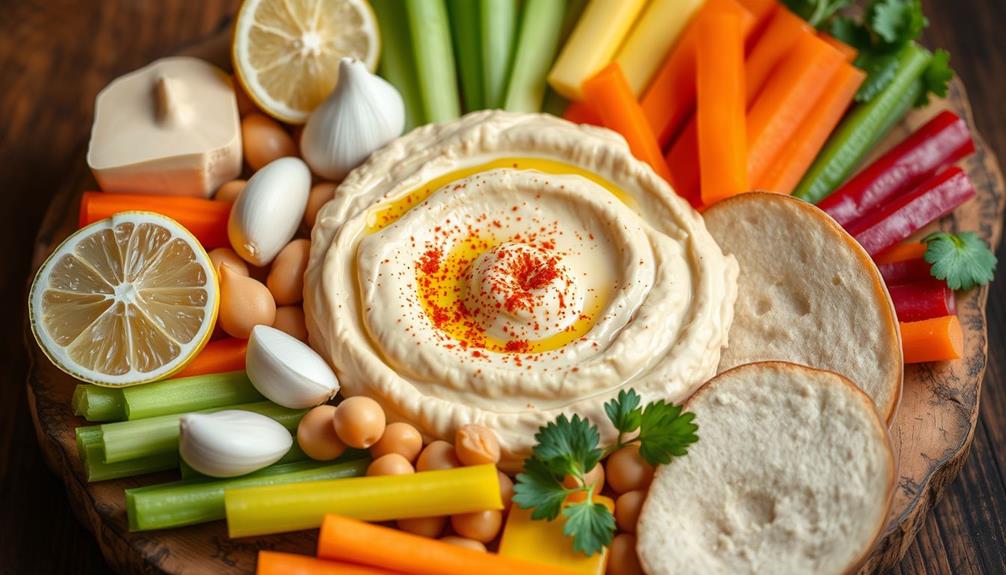
When making raw hummus, you'll want to focus on essential ingredients like raw tahini, fresh peas, and cold-pressed olive oil.
These components not only create a delicious flavor but also pack a nutritional punch.
Additionally, incorporating essential oils for skin conditions can enhance the health benefits of your meal.
Let's explore how to prepare this vibrant dish while maximizing its health benefits.
Essential Raw Ingredients
To create a delicious raw hummus, you'll need a handful of essential raw ingredients that replace the traditional cooked garbanzo beans. This version focuses on maintaining that creamy texture while using wholesome, raw components, which can contribute to your overall mental wellbeing by promoting healthy eating habits.
Here are three key ingredients you'll want to include:
- Zucchini or Fresh Peas: These serve as the base, providing a light and invigorating flavor.
- Raw Tahini: This sesame seed paste adds richness and enhances the overall taste.
- Cold-Pressed Olive Oil: A drizzle of this oil gives your hummus a smooth finish and healthy fats.
Don't forget to add fresh lemon juice for a zesty kick and garlic for an aromatic touch. Blending all these ingredients in a high-speed blender is essential to achieving that perfect creamy texture.
You can also toss in herbs like parsley or cilantro for added flavor and nutrition.
With these essential raw ingredients, you can easily whip up a nutrient-packed hummus that aligns with your raw food diet, satisfying your cravings while keeping it healthy!
Nutritional Benefits Overview
Raw hummus isn't just a tasty alternative; it also packs a punch regarding nutrition. When you choose raw hummus, you're incorporating fresh peas as the primary ingredient. These little green powerhouses are high in protein while being low in calories, making them an excellent fit for your raw food diet.
Additionally, incorporating fresh ingredients often leads to a more vibrant flavor profile and can help you stay hydrated, which is crucial in any diet. Herbal teas like chamomile can complement your meals by aiding digestion and providing relaxation benefits, making it a great pairing with your hummus the benefits of herbal teas.
The nutritional benefits extend beyond just peas. Raw hummus typically includes olive oil, which provides healthy fats essential for your overall well-being. The addition of fresh herbs not only enhances the flavor but also offers vitamins and antioxidants that support your immune system.
Plus, the fiber content from the peas contributes considerably to digestive health. If you want a creamier texture, you can easily add plant milk without compromising the raw principles. This way, you maintain the integrity of the raw food diet while enjoying a rich and satisfying dip.
Incorporating raw hummus into your meals can also encourage you to consume more vegetables, creating a balanced, nutrient-rich approach to your raw vegan lifestyle. So, whether you're snacking or using it as a spread, raw hummus is a nutritious choice that aligns perfectly with your dietary goals.
Preparation Techniques Explained
Creating a delicious raw hummus starts with the right ingredients, so you'll want to gather fresh peas, raw tahini, cold-pressed olive oil, garlic, and fresh lemon or lime juice. These components play a crucial role in achieving a creamy texture and rich flavor in your hummus.
Additionally, incorporating a touch of butter's unique properties can enhance the depth of flavor in various recipes, although traditional hummus recipes focus on raw ingredients.
Here are three key preparation techniques to take into account:
- Blend: Use a high-speed blender to combine your ingredients until smooth. This guarantees all components, including the fresh peas and raw tahini, are fully integrated without losing their raw qualities.
- Adjust Texture: If you prefer a creamier consistency, think about adding a splash of plant milk or a spoonful of nuts or seeds during blending. This will enhance the richness of your hummus.
- Season: Don't forget to taste as you go! Adding fresh herbs like basil or adjusting the amount of lemon juice can elevate the flavor profile considerably.
Remember to check your ingredient sources to avoid any additives or preservatives. Following these preparation techniques will help you enjoy a satisfying, raw hummus that aligns perfectly with your raw food diet!
Preparing Raw Hummus
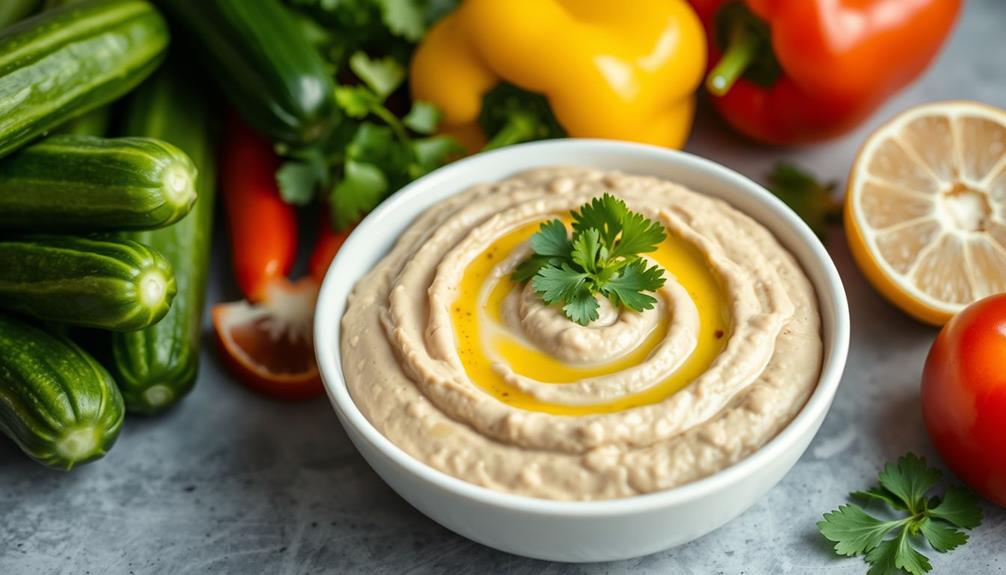
When you're looking for a delicious dip that fits a raw food diet, preparing raw hummus is a fantastic option. Unlike traditional hummus made with cooked chickpeas, this version uses fresh peas or zucchini as the star ingredients. To make your raw hummus, blend fresh peas or zucchini with raw tahini, olive oil, garlic, lemon juice, and your favorite seasonings until you achieve a smooth, creamy texture.
Here's a quick overview of what you'll need:
| Ingredients | Purpose |
|---|---|
| Fresh Peas or Zucchini | Base for the hummus |
| Raw Tahini | Adds creaminess and flavor |
| Olive Oil | Enhances texture |
| Garlic | Provides a savory kick |
| Lemon Juice | Balances flavors |
For the best results, use a high-speed blender to guarantee your raw ingredients blend smoothly. You can also incorporate herbs, nuts, or seeds to boost flavor and creaminess, keeping it aligned with raw food principles. Serve your raw hummus with fresh vegetables or raw crackers for a nutrient-dense dip that encourages more raw produce in your diet!
Tips for Incorporating Hummus
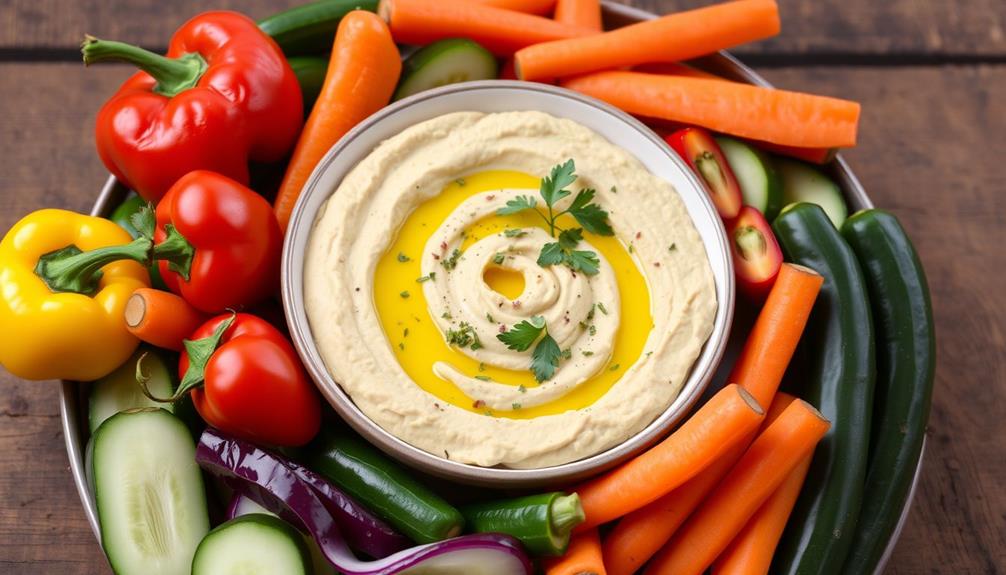
Incorporating hummus into your meals can elevate your raw food diet while adding a burst of flavor. By making raw hummus with ingredients like peas or zucchini, you can create a creamy, delicious dip that aligns perfectly with your raw vegan lifestyle.
Additionally, using fresh ingredients can improve your overall health and well-being, similar to how glycolic acid aids in exfoliation for scalp health. Here are some tips to help you enjoy your raw hummus:
- Use fresh ingredients: Opt for cold-pressed olive oil and raw tahini to keep your hummus compliant. Fresh herbs and spices can really enhance the flavor, so don't be shy!
- Pair with vegetable dippers: Serve your raw hummus with an array of colorful vegetable dippers such as carrot sticks, cucumber slices, and bell pepper strips. This not only adds crunch but also boosts your intake of fresh fruits and veggies.
- Experiment with flavors: Try adding ingredients like avocado or nutritional yeast to create unique textures and tastes in your raw hummus. This keeps your meals exciting and satisfying while sticking to your dietary goals.
With these tips, you can effortlessly incorporate raw hummus into your diet, making every meal delicious and nutritious!
Frequently Asked Questions
Can You Eat Chickpeas on a Raw Food Diet?
You can't eat regular chickpeas on a raw food diet since they're typically cooked. But, you can enjoy sprouted chickpeas, which enhance digestibility and retain nutrients, or use raw alternatives like zucchini or peas instead.
Can You Eat Hummus on Clean Eating?
You can eat hummus on a clean eating diet, but make sure it's made from whole, raw ingredients. Always check labels for additives, or better yet, prepare your own using fresh vegetables and raw nuts.
What Can't You Eat on a Raw Food Diet?
On a raw food diet, you can't eat cooked grains, legumes, or animal products. Processed foods, refined sugars, and traditional dairy are off-limits too. Focus instead on fresh fruits, vegetables, nuts, and seeds.
What Is Raw Humus?
Raw hummus is a fresh, creamy spread made from raw ingredients like sprouted beans or peas, blended with herbs and nuts. It's nutritious, offering essential proteins and antioxidants, and pairs well with fresh veggies.
Conclusion
Incorporating raw hummus into your raw food diet can be a delightful dance of flavors and textures. With fresh, vibrant ingredients, you're not just nourishing your body; you're savoring nature's bounty. So, whip up a batch, dip in some crunchy veggies, and let your taste buds commence a journey of pure, unprocessed joy. Remember, eating raw doesn't mean sacrificing flavor—it means celebrating it in its most vibrant form! Enjoy every bite!

